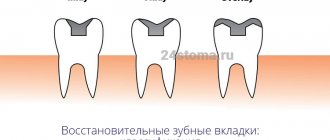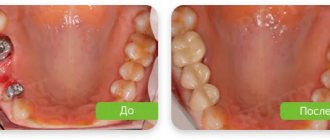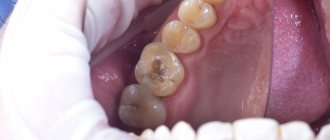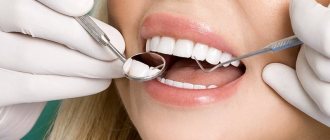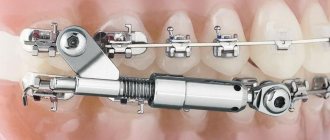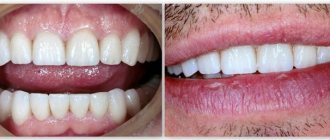Fillings made from various materials are good for everyone when used according to indications. And the readings of fillings are limited to the volume of the defect not exceeding 40% of the hard tissue of the tooth. In practice, this means approximately average caries: usually the tooth damage is amphora-shaped, that is, in the form of a cavity with a narrow neck. From the outside, it is very difficult for the patient to assess the true volume of lost tissue. There is a stereotype that you can just put a filling on top, and that’s fine. Dentists are in no particular hurry to dispel these thoughts and, for their own reasons, often expand the indications for fillings. For example, because of conservatism or because it is better to close this cavity with something rather than not touching it at all or performing more complex operations that the patient may not undergo because of their cost.
In short: large fillings were a temporary solution until the advent of more reliable ways to close a cavity in a tooth. They can’t be installed, but they are still being installed.
What's wrong with a large filling with expanded indications? It’s very simple: its material (most often a polymer) shrinks by 2–6% by volume during hardening. This means that it does not adhere tightly to the tooth tissue. When the load is transferred to the tooth in the right situation, it is distributed along the axis evenly both to the filling and to the remaining hard tissue, and then to the tooth root. In the case of a large filling, the load falls on hard tissues (and there are less than 60% of them left according to the expansion of indications). In practice, this means a broken tooth five to eight years after filling. You'll be lucky if it's broken above the gum level: we'll restore it with a crown. You won't be lucky if it's lower: it will require removal, most likely bone augmentation, and only then expensive implantation.
The solution is ceramic inlays. It's almost like fillings, only completely different. The main difference is that they are introduced not in the form of layer-by-layer polymer, but in the form of a solid product prefabricated on a CNC milling machine (or other device). They require a laboratory and a machine for their production, photogrammetry of the oral cavity, a 3D image and software for precise design for the patient. It turns out tens of times better, but more expensive.
What are the fundamental differences between ceramic inlays and fillings?
The filling is created by layer-by-layer filling of the material and processing it with a lamp. This means that bottlenecked amphora-shaped cavities can be filled without widening the neck. In the case of small fillings, the technology is good enough that there is nothing to change about it other than generations of materials. In the case of large fillings, shrinkage of the material creates a cavity (long gap) between the filling and the tooth tissue. The filling almost does not begin to “hang out” in the amphora-shaped cavity, but this gap is a fairly large opportunity for bacteria to enter this space and cause relapse of caries. Recurrence of caries under a large filling is the most common complication and the most common problem with large fillings. In this case, the filling cannot come out of the cavity because the neck is narrow. At the same time, the distribution of the load on the tooth suffers, so you can then expect a chip - a broken tooth due to the lack of sufficient structural strength of the remaining tissues.
Here is an example of a large seal that has depressurized and its replacement with a tab:
Before.
At the treatment stage.
After.
The insert is machined to fit a specific cavity and inserted into it with an accuracy of 1/10 of a millimeter. It is fixed with essentially the same material from which the filling is made, but this layer is very thin and acts as glue. Its shrinkage has almost no effect on the strength of the connection. The strength of the connection is almost comparable to chemical bonds (but in practice these are micromechanical connections). The tab can be removed only by sawing it out, while the filling is often removed with tweezers after five to six years. The service life of the filling is only up to eight years, with the expansion of indications and the gap being two to three times less. The service life of the tab is up to 25 years, and it is very easy to extend it. In practice, I glued tabs placed on early polymers that were just about that old. Modern materials should provide lifelong service, but it has not yet been possible to check.
An inlay is often more aesthetically pleasing because it allows you to design the shape of the tooth much more accurately and ensure minimal differences in the appearance of the material.
The inlay is fixed in the same way as a filling: the monomeric material polymerizes under the influence of light at a wavelength of about 400–500 nm. The ceramic inlay is partially transparent, like a natural tooth, but is inserted as a whole product, which requires a different lamp power to polymerize the lower layers of the bonding material. This is another reason why they are rarely used in a regular clinic: you need a lamp not for 200–350 dollars, but for 1,000–2,000. On the other hand, if the inlay is thick enough, then you can use dual-curing cements and do without an emitter.
Microprosthesis care
People who have had their teeth restored using an inlay need to carefully care for their oral cavity. You should brush your teeth morning and evening and do this for at least 2 minutes. After each meal, you should use a dental rinse.
Ceramic inlays are a modern and reliable method of microprosthetics. With their help, you can restore even a badly damaged tooth, which allows the row to look aesthetically pleasing. During dental procedures, the patient experiences much less discomfort than when installing a filling, and the ceramic inlay lasts much longer.
More examples
Example 1:
Here the tooth is cracked due to a large filling.
Example 2: filling with usual indications
Given:
Correct fillings:
Design differences
Composite
- Installed in one visit.
- The structure is looser, so over time the shade changes under the influence of food and drinks that have a coloring effect (tea, coffee, red wine, products containing dyes).
- It is necessary to polish systematically (at least once a year).
- The service life is 5-7 years, then an update is required.
Ceramic:
- Installation will require at least 2 visits to the doctor.
- Retains original color and shine throughout the entire period of use.
- Does not require professional care.
- The service life is 10-15 years.
Composite orthopedic plates are 2-3 times cheaper than porcelain ones.
Are inlays better than fillings?
Like any type of treatment, it is neither good nor bad in general, but there is always a choice depending on the indications. In Russia, historically, composite filling materials have been used very widely, and there are doctors with excellent manual skills who can make anything out of them. Formally, you can even build a house from a composite, illuminated by a lamp. This allows you to expand the readings. This is more than justified in regional clinics, when the patient is short on funds or simply does not have access to the necessary equipment. In clinics with access to intraoral scanners and an in-house or independent ceramic laboratory, expanding indications is not medically acceptable. From an economic point of view, let’s say, these are borderline cases.
Our CNC milling machine.
Are there any complications?
As noted earlier, preparing a damaged tooth for installation of an inlay involves excision of hard tissue. This is done so that the internal cavity takes on the desired shape. Due to the fact that such a procedure is very similar to a surgical operation, when preparing a tooth for an inlay, a chronic or acute form of pulpitis and secondary caries may occur.
Patients suffering from increased tooth sensitivity usually experience discomfort after installing an inlay. Opening the cavity can lead to the inlay falling out of the tooth. If this happens, you should immediately visit the dentist's office where this product was installed. If possible, you should take it with you, then the doctor will treat the surface of the tooth and glue the tab back. If the tab was lost, you will have to pay money again for production.
Why is precision inlay design necessary?
For small interventions, manual precision work with fillings and additional correction is sufficient.
In large reconstructions, it is often necessary to restore the cusps on the teeth that ensure proper contact. We build an occlusal compass to model the oral cavity so that movements are limited, that is, to ensure the correct mechanics of teeth closure. It is basically impossible to do the same thing in the mouth using filling material. Yes, you can achieve aesthetics with fillings, but correct mechanics with large interventions with several teeth is almost never possible. When a filling is required not on top, but on the side surface of the tooth, it is necessary to restore the contact point (so that the thread passes with a click): this is necessary so that food does not pass down and injure the periodontal papilla. It is very difficult to restore the contact point with the correct anatomy. In addition to the contact point itself, there is an approximal ridge with a triangular fossa. He rolls the food bolus not between the teeth, but towards the chewing surface of the tooth:
On a filling it is often not easy to do this manually. And another difficulty is when we have a defect on the side, and it is critically important that the restoration or filling is level with the level of the tooth: if it is wider, then food will get there and there will be caries below. If already, there will be a step that will create mechanical difficulties.
Indications and contraindications
The main indications for restoring the aesthetics of elements using structures:
- increased abrasion of enamel;
- severe mechanical damage to the crown of the tooth;
- destruction of the crown by more than 30%;
- the need to use the unit as a support for the prosthesis;
- using ceramic inlays instead of fillings.
The products are an improved version of fillings that are made to order. Installation of structures is not possible in all cases.
Contraindications for the procedure are:
- the need to restore milk elements;
- destruction of the crown by more than 60-70% (in this case, doctors offer crowns to patients);
- lack of a healthy root system of the tooth;
- serious mechanical damage to the unit, in which nothing remains of it;
- destruction of incisors or canines (inlays, as a rule, are not used for the restoration of these elements);
- progression of carious processes in the oral cavity.
Photos before and after installing a ceramic inlay
Experts also do not recommend restoring wisdom teeth using ceramic structures. Eights do not play any role in the process of chewing food and are invisible to others, so there is no point in spending money on their expensive restoration.
What else do you need to know about tabs?
The ceramic products themselves will be found unchanged at the excavations of your home.
Most likely, your remaining teeth will degrade, but the inlays will remain the same. But the material that creates micromechanical connections with the hard tissues of the tooth degrades and accumulates mechanical fatigue. Research is currently underway to improve its qualities. Of importance, composites based on glass ionomer cements have long been widely used. They are very friendly to dentin and release fluoride, which is a cellular poison for bacteria. It is impossible to make a filling entirely from such cements: it will be mechanically unstable and of poor aesthetics. We use this material if there are deep cavities or if we are concerned about possible inflammation of the pulp. We place a layer of this material under the inlay: the overall result is a structure that is good in relation to tooth tissues and is quite stable, capable of withstanding loads. Glass ionomer cement alone cannot withstand loads without an inlay. Inlays protect against hidden tooth defects. If a tooth with a filling cracks, this often means almost the same type of damage as when triplex glass is damaged: the fracture site and many microcracks are visible. Many of them are difficult to track, but in general the material is degrading. If such cracks reach the root, they become a gateway for infection and cause a purulent inflammatory process. This means much more complex consequences, including rapid loss of bone tissue: a defect is formed in the bone tissue, and then there is nothing to put an implant into. We will have to remove the tooth, augment it with xenogeneic bone or mixed with autogenous material.
From scanning to the finished restoration, the patient waits at least 40 minutes - this is design and milling. In complex cases, this is two hours; the median case in the clinic’s practice, taking into account cavity preparation, is about 90 minutes. An inlay for one tooth costs from 44,000 rubles, while a filling for one tooth costs from 9,000 rubles.
PS If you come to our clinics, then say that you are from Habr, there will be a 5% discount.
Product installation technology
Below is a detailed process for installing ceramic products.
Table. Procedure for installing ceramic inlays.
| Steps, photo | Description of actions |
| If there are old fillings, they are first removed using a special machine. Cooling with water helps prevent tooth overheating. Grinding of the tooth being restored occurs using magnifying instruments, most often binocular glasses. This is due to the need to preserve as much healthy dental tissue as possible. | |
| After grinding, the tooth surface is treated with a special tool - a caries detector. It is washed off the teeth when rinsing with water. The caries detector allows you to check whether all damaged tooth tissue has been removed from the patient. | |
| After this, precise grinding is carried out, and at the end all edges of the processed tooth are smoothed with an Arkansas stone. All these actions are necessary to improve the fit of the ceramic inlay. | |
| Before taking an impression, a special protective agent is applied to the tooth, which is also washed off when rinsing. After this, an impression is taken for the dental technician. The test is also carried out using binocular glasses. | |
| Now the manufactured tab is glued. For this purpose, different types of glue are used: some harden under the influence of ultraviolet light, others need to be mixed before application. In any case, the doctor must strictly follow the manufacturer's instructions. This also applies to all substances for treating teeth, including special polishing pastes, etching gel, glycerin gel for glue hardening, and so on. |
On a note! There are special rules of oral hygiene that the patient must follow after installation of the structure. This will reduce the load placed on the restored tooth, as a result of which the microprosthesis will last much longer.
Types of dental prosthetics
Today, the difference between the concepts of crowns, inlays, onlays and veneers has been greatly erased. All of the listed types of restorations are manufactured according to the same protocols using the same technologies and are fixed in the same way, so doctors often call all this a general term - adhesive restorations .
The use of certain prosthetic or restoration methods depends on the specific clinical situation and indications. The orthopedic doctor takes into account the patient’s characteristics, muscle structure and tension, and type of chewing. There is a lot to consider when making a decision. Therefore, it is impossible to say unequivocally: “If such a part of the tooth is destroyed, this is the inlay; the larger part of the tooth is the crown.”
Types of adhesive restorations: crowns, inlays, onlays
There are always half measures. For example, in one case we understand that functionally we can get by with an onlay, but from an aesthetic point of view we would like to increase the area, change the shape, color - in this case we get almost a half-crown.
The most important thing in dental prosthetics is a detailed discussion of options with the patient, careful treatment planning and accurate modeling of structures. The main advantage of orthopedic dental restoration is that it is possible, so the treatment result is precise and durable.
Where is the best place to place veneers?
It's no secret that aesthetic operations such as the installation of veneers should be carried out only in serious and trusted clinics. From the best specialists. They are professionals in their field, with thousands of successfully performed veneering and aesthetic dental restoration operations behind them.
Why do we offer installation of veneers here, in our clinics?
All-Russian
The rating of private dental clinics in 2022 confirmed
the leadership
of the German Implantology clinics and the “Clinic over 3 years old”.
11,000 of the best
Russian dental clinics from more than 110 cities fought for the right to be the first, and we again became the best in Russia!
The award ceremony took place on September 23, 2022
within the framework of the largest dental exhibition in Russia -
DENTAL EXPO 2019
and
on September 22, 2022
at the
DENTAL EXPO 2020
.
In the category “Clinics up to 3 years of age” - the clinic of the Research Center in Ramenki:
In the category “Clinics over 3 years old” - the clinic of the Scientific Research Center on Kievskaya,
which has been successfully performing dental implantation for more than 9 years:
